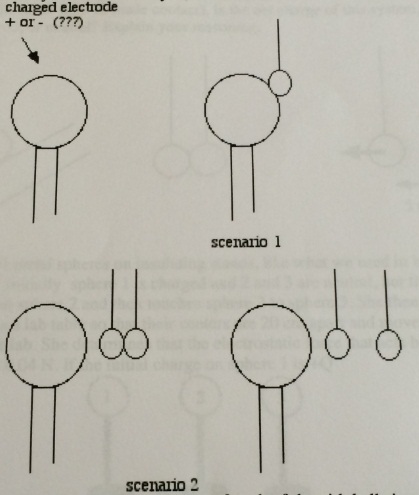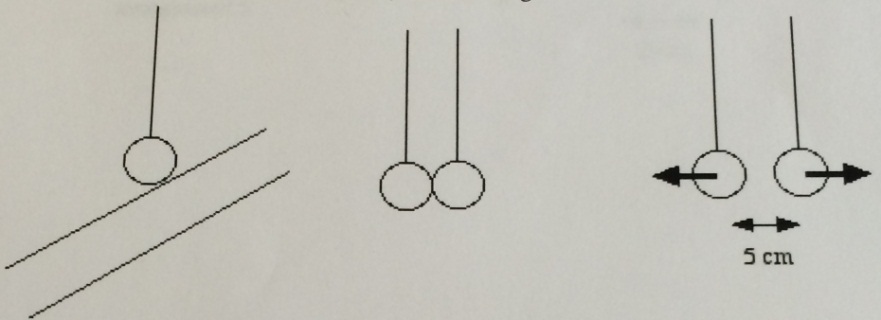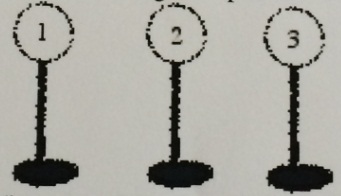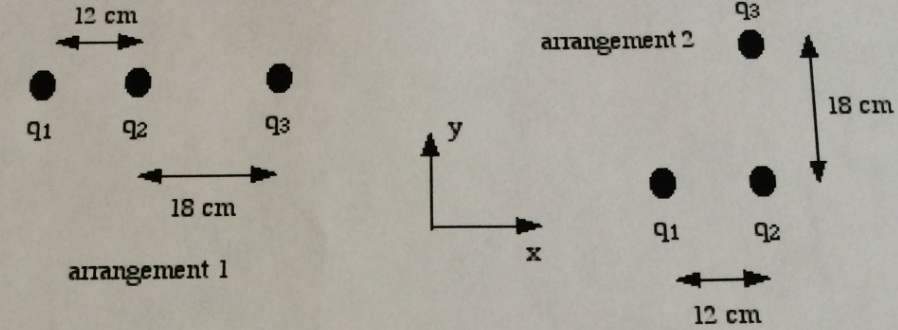Assignment:
Problems:
1) A Wimshurst machine (just like in lab) is used to conduct some electrostatics experiments. In one experiment (scenario 1 below) two identical and initially uncharged pith balls (held on wooden sticks) separately touch one electrode of the machine after it has been charged. Recall that pith balls are covered with a conducting coating such as graphite. In a second experiment (scenario 2) the machine is recharged and the pith balls allowed to discharge so that they are again neutral. Holding the pith balls in contact the experimenter brings them close to one of the charged electrodes, one ball is closer than the other, but doesn't let either ball touch the electrode. Contact between the pith balls is then broken while they are in the vicinity of the electrode.

a) For each scenario describe the charged state of each of the pith balls in terms of whether it is like or unlike the electrode. Explain your reasoning.
b) Assuming that the electrode is positively charged, describe the electron flows that occur in each scenario.
c) If the initial charge on the electrode is Q (could be + or -) , what is the net charge of each of the "systems" below after any charging of the pith balls has taken place:
System I: This system consists of the electrode and both pith balls in scenario 1.
System II: This system consists of the electrode and both pith balls in scenario 2.
System III: This system consists of only the two pith balls in scenario 2.
2) Initially both a small pith ball, with a conductive coating, that hangs from a string and a plastic PVC rod are neutral. The pith ball is rubbed against the rod with enough friction to charge both objects.
a) How should the charge state of the pith ball compare to the charge state of the rod after the two objects are rubbed together. Explain your reasoning.
b) The charged pith ball ball is then brought into contact with a second identical and initially uncharged pith ball. After touching the two pith balls repel and when placed so that their centers are 5 cm apart the repulsive force is measured to be 0.006 N. Use this information to determine the amount charge on the rod.
c) Consider a system consisting of the charged rod and either (but not both) of the charged pith balls (after they've made contact). Is the net charge of this system, like the rod, unlike the rod, or neutral? Explain your reasoning.

3) Three identical metal spheres on insulating stands, like what we used in lab, are used in an experiment. Initially sphere 1 is charged and 2 and 3 are neutral, but then a student touches sphere 1 to sphere 2 and then touches sphere 2 to sphere 3. She then places spheres 1 and 2 on a lab table so that their centers are 20 cm apart and moves sphere 3 to another part of the lab. She determines that the electrostatic force that acts between spheres 1 and 2 is 0.04 N. If the initial charge on sphere 1 is +Q

a) Describe the charge state (in terms of Q) of each sphere after the described procedure has been completed. Is the measured force repulsive or attractive? Explain your reasoning.
b) Determine Q.
4) Two arrangements of the same three small charged spheres are constructed. In the first arrangement the spheres are placed in a line, and in the second the spheres are at the vertices of a triangle with sphere 3 directly above sphere 2 (same x coordinate). If q1=-4.0 µC, q2= +1.0 μC and q3=-8.0 μC. Determine the magnitude and direction (specify the angle the vector makes with the positive x axis) of the net electrostatic force that acts on sphere 1 for each arrangement.
